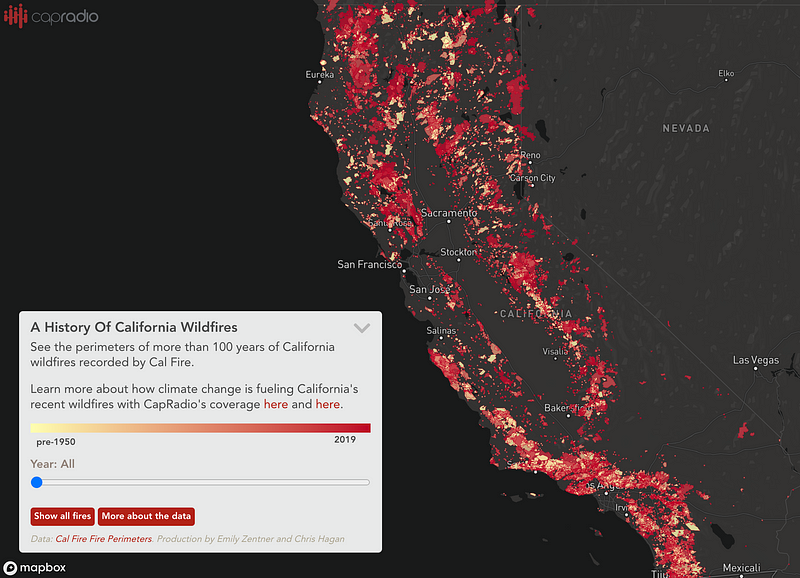Ash fell onto the balcony of our apartment as smoke lowered onto the field in front of our dorms. It was 2007, my first year of college and the sky was burning over the campus of UC San Diego. We escaped up interstate highway 5, ironically headed to Alhambra, CA in Los Angeles, for cleaner air as wildfires licked the hills along the freeway.
Fast forward 13 years to 2020 in California. Amidst a global pandemic, wildfires made headlines in California. This time, the entire state was covered in smoke for several weeks. Nowhere to escape.
I was curious to know–will there be more fires? How much worse? Have we seen the worst after 2020 topped megafire records? Or is this the tip of the iceberg?
Some history: California is fire country. Fires are endemic to California and part of the natural landscape. 100 years of fire data shows us this much:

Most of the state burned at one point or another. According to research about prehistoric California, at least 4.4 million acres burned annually: “Skies were likely smoky much of the summer and fall in California during the prehistoric period.”
Wildfires burned 4.4 million acres of our sunny state last year. Was this an outlier event? In the context of California fire history, 2020 turns out to be an exactly average year.
While 2020 was an average year in terms of acres burned, 6 of the 20 largest wildfires in California history burned last year. Average year in terms of acreage, outlier in terms of intensity, destruction, and disruption to the highest number of lives.
Sobering thought.
You might wonder, as I did, if last year’s fires means we’ve burned most of what could burn, lessening the threat of future fires. My optimism was extinguished when I learned California is sitting on a backlog of megafires waiting to happen:
“Between 1982 and 1998, California’s agency land managers burned, on average, about 30,000 acres a year. Between 1999 and 2017, that number dropped to an annual 13,000 acres. The state passed a few new laws in 2018 designed to facilitate more intentional burning. But few are optimistic this, alone, will lead to significant change. We live with a deathly backlog. In February 2020, Nature Sustainability published this terrifying conclusion: California would need to burn 20 million acres — an area about the size of Maine — to restabilize in terms of fire.”
We halted nature from running it’s natural course of burning firewood, creating a pile. of fuel prone to blow-ups like we saw in 2018 and 2020.
Assuming our backlog is static, we are left with roughly 15.6 million acres of dry powder after last year’s fire season. Of course, the backlog is not static. Trees and brush don’t suddenly take a break from turning into firewood.
Climate change has intensified California’s persistent drought situation, turning native bark beetles into the mortal enemy of California pines. The result? An estimated 129 million trees have died since 2010, much of it attributed to the drought and beetles. These dead trees were implicated for fueling last year’s fires, along with climate change driving increases in lightning storms. Regardless, the dry powder stash grows.
Extreme weather systems from climate change combined with California’s “sequester all fires” policy has one result: a powder keg of wildfires waiting to blow up. Simple math and respect for nature means another major wildfire, even bigger than the 2020 wildfires that lit the entire state on fire, is inevitable.
The San Diego fire that burned during our first year in college was the 14th largest in California history, burning just shy of 200,000 acres. A large fire. Over a decade later, we experienced a fire 5 times the size with larger ones to come. Well, that’s a scary thought.
The California Governor stated: “fires in California are caused by climate change”. A former President blamed California’s poor forestry management. Neither is wrong. But holding onto their party lines while ignoring the other side is how we’ll get into more trouble. If we can get away from the polarizing politics and combine the two statements, it would give us the exact platform to progress California in this domain.
Note: ProPublica’s deep dive on the entire wildfire topic is worth a read as it covers the politics, federal budgets, mis-incentives, and the use of prison labor.